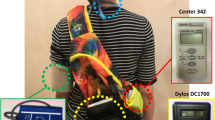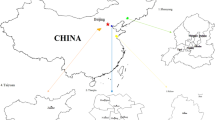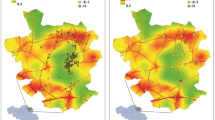Abstract
Although fine particulate matter (PM) air pollution <2.5 μm in aerodynamic diameter (PM2.5) is a leading cause of global morbidity and mortality, the potential health effects of coarse PM (2.5–10 μm in aerodynamic diameter; PM10–2.5) remain less clearly understood. We aimed to elucidate the components within coarse PM most likely responsible for mediating these hemodynamic alterations. Thirty-two healthy adults (25.9±6.6 years) were exposed to concentrated ambient coarse PM (CAP) (76.2±51.5 μg/m3) and filtered air (FA) for 2 h in a rural location in a randomized double-blind crossover study. The particle constituents (24 individual elements, organic and elemental carbon) were analyzed from filter samples and associated with the blood pressure (BP) and heart rate (HR) changes occurring throughout CAP and FA exposures in mixed model analyses. Total coarse PM mass along with most of the measured elements were positively associated with similar degrees of elevations in both systolic BP and HR. Conversely, total PM mass was unrelated, whereas only two elements (Cu and Mo) were positively associated with and Zn was inversely related to diastolic BP changes during exposures. Inhalation of coarse PM from a rural location rapidly elevates systolic BP and HR in a concentration-responsive manner, whereas the particulate composition does not appear to be an important determinant of these responses. Conversely, exposure to certain PM elements may be necessary to trigger a concomitant increase in diastolic BP. These findings suggest that particulate mass may be an adequate metric of exposure to predict some, but not all, hemodynamic alterations induced by coarse PM mass.
This is a preview of subscription content, access via your institution
Access options
Subscribe to this journal
Receive 6 print issues and online access
$259.00 per year
only $43.17 per issue
Buy this article
- Purchase on Springer Link
- Instant access to full article PDF
Prices may be subject to local taxes which are calculated during checkout




Similar content being viewed by others
References
Brook RD, Rajagopalan S, Pope CA III, Brook JR, Bhatnagar A, Diez-Roux A et al. Particulate matter air pollution and cardiovascular disease. An update to the scientific statement from the American Heart Association. Circulation 2010: 121: 2331–2378.
Brunekreef B, Forsberg B . Epidemiological evidence on effects of coarse airborne particles on health. Eur Respir J 2005; 26: 309–318.
Chang HH, Peng RD, Dominici F . Estimating the acute health effects of coarse particulate matter accounting for exposure measurement error. Biostat 2011; 12: 637–652.
Peng PD, Chang HH, Bell ML, McDermott A, Zeger SL, Samet JM et al. Coarse particulate matter air pollution and hospital admissions for cardiovascular and respiratory diseases among Medicare patients. JAMA 2008; 299: 2172–2179.
Puett RC, Hart JE, Yanosky JD, Paciorek C, Schwartz J, Suh H et al. Chronic fine and coarse particulate exposure, mortality, and coronary heart disease in the Nurses’ Health Study. Environ Health Perspect 2009; 117: 1697–1701.
Zanobetti A, Schwartz J . The effect of fine and coarse particulate matter air pollution on mortality: A national analysis. Environ Health Perspect 2009; 117: 898–903.
Brook RD, Bard RL, Morishita M, Dvonch JT, Wang L, Yang H-Y et al. Hemodynamic, autonomic, and vascular effects of exposure to coarse particulate matter air pollution from a rural location. Environ Health Perspect 2014; 122: 624–630.
Brook RD, Urch B, Dvonch JT, Bard RL, Speck M, Keeler G et al. Insights into the Mechanisms and Mediators of the Effects of Air Pollution Exposure on Blood Pressure and Vascular Function in Healthy Humans. Hypertension 2009; 54: 659–667.
Demokritou P, Gupta T, Ferguson S, Koutrakis P . Development and laboratory characterization of a prototype coarse particle concentrator for inhalation toxicology studies. Aerosol Sci 2002; 33: 111–123.
Moffet RC, Shields LG, Berntsen J, Devlin RB, Prather KA . Characterization of an ambient coarse particle concentrator used for human exposure studies: aerosol size distributions, chemical composition, and concentration enrichment. Aerosol Sci Technol 2004; 38: 1123–1137.
Harkema JR, Keeler GJ, Wagner JG, Morishita M, Timm E, Hotchkiss J et al. Effects of inhaled urban air particulates on normal and hypersecretory airways in rats. Health Effects Institute Research Report 120. Health Effects Institute: Boston MA, 2004.
Arrindell WA, van der Ende J . An empirical test of the utility of the observations-to-variables ratio in factor and components analysis. Appl Psychol Meas 1985; 9: 165–178.
Bryant FB, Yarnold PR . Principal components analysis and exploratory and confirmatory factor analysis. Reading and understanding multivariale statistics. American Psychological Association: Washington, DC, 1995, pp99–136.
Mason B, Moore CB . Principles of geochemistry. Wiley: New York, 1982.
Gao Y, Nelsonb ED, Fielda MP, Ding Q, Li H, Sherrella RM et al. Characterization of atmospheric trace elements on PM2.5 particulate matter over the New York–New Jersey harbor estuary. Atmos Environ 2002; 36: 1077–1086.
Edgerton ES, Hartsell BE, Jansen JJ . Mercury speciation in coal-fired power plant plumes observed at three surface sites in the southeastern U.S. Environ Sci Technol 2006; 40: 4563–4570.
The Pesticide Action Network Database. http://www.pesticideinfo.org/ “Copper Arsenate”. Accessed 15 February 2014.
Widdiocombe J, Lee L-Y . Airway reflexes, autonomic function, and cardiovascular responses. Environ Health Perspect 2001; 109: 579–584.
Fariss MW, Gilmour MI, Reilly CA, Liedtke W, Ghio AJ . Emerging mechanistic targets in lung injury induced by combustion-generated particles. Tox Sci 2013; 132: 253–267.
Hazari MS, Haykal-Coates N, Winsett DW, Krantz QT, King C, Costa DL et al. TRPA1 and sympathetic activation contribute to increased risk of triggered cardiac arrhythmias in hypertensive rats exposed to diesel exhaust. Environ Health Perspect 2011; 119: 951–957.
Simon SA, Liedtke W . How irritating: the role of TRPA1 in sensing cigarette smoke and aerogenic oxidants in the airways. J Clin Invest 2008; 188: 2383–2386.
Acknowledgements
This study was funded by grants from the NIH CTSA (UL1RR024986) and from the United States Environmental Protection Agency RD83479701 and R833740. We thank James Barres, Sue Lustig, Mary Lynam, and Matt Salvadori for their field efforts.
Author information
Authors and Affiliations
Corresponding author
Ethics declarations
Competing interests
The authors declare no conflict of interest.
Additional information
Supplementary Information accompanies the paper on the Journal of Exposure Science and Environmental Epidemiology website
Supplementary information
Rights and permissions
About this article
Cite this article
Morishita, M., Bard, R., Wang, L. et al. The characteristics of coarse particulate matter air pollution associated with alterations in blood pressure and heart rate during controlled exposures. J Expo Sci Environ Epidemiol 25, 153–159 (2015). https://doi.org/10.1038/jes.2014.62
Received:
Revised:
Accepted:
Published:
Issue Date:
DOI: https://doi.org/10.1038/jes.2014.62
Keywords
This article is cited by
-
Effects of urban fine particulate matter and ozone on HDL functionality
Particle and Fibre Toxicology (2015)



